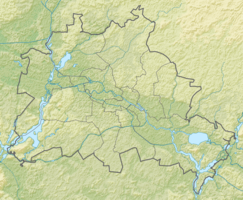Malchower Aue
|
Malchower Aue
|
||
|
Entrance to the floodplain from the direction of Malchow, exit Blankenburger Pflasterweg |
||
| location | Berlin-Malchow , Germany | |
| surface | 22.2 ha | |
| Identifier | NSG-27 | |
| WDPA ID | 164560 | |
| Geographical location | 52 ° 35 ' N , 13 ° 29' E | |
|
|
||
| Setup date | March 7, 1995 | |
The Malchower Aue is a 22.2 hectare nature reserve in the Berlin district of Malchow in the Lichtenberg district .
history
At the end of the Vistula glaciation about 10,000 years ago, the meltwater dug a channel in the Barnim , a plateau formed by the Ice Age. The channel flows into the Malchower See in the south . The gradual silting up of the basin, which was initially filled with water, created a fen . The moor was drained in the 18th century with the help of a ditch, which is now called Dorfgraben Malchow. The areas created were used as meadows . The Malchower Aue was located in the middle of the Malchower Rieselfelder , which was cultivated from 1884 to 1969. In 1931 the allotment garden complex Wiesenhöhe was founded in the Malchower Aue, which was expanded in 1951. In 1979 the use of the meadow was largely abandoned and large areas of peat were mined until 1983. A smaller part of the mining area was filled with excavated soil and building rubble. The material came from the large construction site of the Hohenschönhausen-Nord prefabricated housing estate ( Neu-Hohenschönhausen district since 2002 ), which was built from 1981 to 1989. The rest remained as open bodies of water. In 1985 there was a plan to create a Malchower See park in 1990. The Malchower Aue was to become part of the Volkspark . The excavated earth dump was to become a winter sports hill with a viewpoint. Because of the turning point and peaceful revolution in the GDR , the plan was not implemented. The prefabricated building area was redeveloped from 1990 to 1997. A broken concrete landfill was added to the excavated earth dump in the Malchower Aue. In 1994 the two landfill mounds were covered with excavated earth from the construction site of the Linden Center in Hohenschönhausen and the landfill was closed. A storage area on Wartenberger Weg has been preserved. The Malchower Aue was placed under protection in 1995 in order to preserve the fen meadows with the peat cuttings and the adjoining quarry forest .
Design
The 22.2 hectare area includes remnants of the wet meadows and alder forests that characterize the entire lowland, seven ponds created by peat cutting and called peat cutting with reed beds and grassland rich in shrubs. In the mid-1980s, excavated soil from the Hohenschönhausen-Nord prefabricated housing estate was unloaded in the southeast of the site. After this topsoil dump was covered with mulch in 1992, warmth-loving plants and semi-arid grassland, which are untypical for moist lowlands, settled. There is a lookout point on the resulting hill.
fauna and Flora
In the Malchower Aue there are over 300 higher plant species, around 40 species of birds, six species of amphibians, seven species of fish and larvae of around 20 different dragonflies. Example adhesion may be mentioned Gray thistle (Cirsium canum), willow , dwarf mouse , Whinchat , dovetail , Beutelmeise , common toad , common frog , three-spined stickleback , Kingfisher , Reed Warbler , Common Blue , blood droplets , Stieglitz , Darter , Tufted , reed bunting , white stork , green woodpecker and nightingale .
Web links
- NSG Malchower Aue / Nature Conservation in Berlin / State of Berlin. In: berlin.de.
- World Database on Protected Areas - Malchower Aue (English)
Individual evidence
- ^ A b NSG Malchower Aue / Nature Conservation in Berlin / State of Berlin. In: berlin.de. Retrieved April 26, 2020 .
- ↑ Malchower See and Malchower Aue. In: fotowiesel.de. Retrieved April 26, 2020 .


